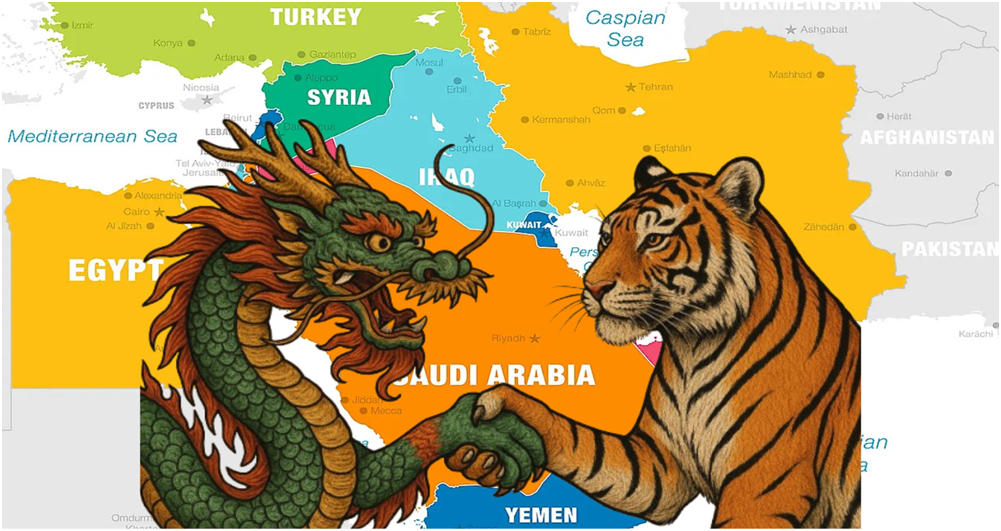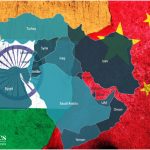China’s recent diplomatic initiatives in West Asia, most notably its facilitation of the Saudi-Iran rapprochement in 2023, have generated both curiosity and concern. While some narratives frame China’s rising role as a threat to Indian influence, a deeper strategic reading suggests otherwise. In fact, China’s engagement may create a more stable regional environment that indirectly benefits India. Rather than viewing China’s rise as a zero-sum game, it is essential to assess how India’s long-standing socio-economic linkages, diplomatic capital, and unique transactional approach position it to thrive in a multipolar West Asia. Economic and diplomatic engagements generally do not fall under a zero-sum game, where the gain of a party is a loss to others; rather, it falls under a win-win situation where every party gets something.
Rising Asian Transactionalism: A New Diplomatic Context
As argued in “Rising Asian Transactionalist Players in the Middle East: Deciphering the Roles of China and India in the Persian Gulf,” written by Sujata Aishwarya and Chuchu Zhang, both China and India approach the region through a transactional lens, eschewing value-based diplomacy for pragmatic, interest-driven engagements. China brings infrastructure and investment; India offers labour, education, soft power, and crisis diplomacy. These differing approaches are not necessarily antagonistic—in fact, they are often complementary. Transactionalism allows both states to pursue parallel yet independent regional agendas without direct conflict.
Moreover, this transactional mode of engagement provides regional states—particularly the Gulf monarchies and Iran—greater agency in choosing their partners. India, with its non-interventionist posture and respect for sovereignty, becomes a natural and welcome counterpart to Chinese capital-intensive diplomacy. In such a competitive yet decentralized environment, India’s distinct strengths continue to be relevant.
Saudi-Iran Rapprochement: A Net Positive for India
China’s brokering of peace between Saudi Arabia and Iran reduces the likelihood of regional conflict, which has historically disrupted energy supplies and endangered Indian expatriates. A stable Gulf enhances India’s energy security and economic planning. With de-escalated tensions, India can pursue deeper bilateral relationships with both Riyadh and Tehran without being forced into geopolitical balancing acts.
Additionally, this rapprochement indirectly facilitates India’s broader regional projects. Connectivity initiatives like the International North-South Transport Corridor (INSTC) and the India-Middle East-Europe Economic Corridor (IMEC) are predicated on stability across borders. Reduced hostilities enable smoother trade routes and reduce insurance premiums and shipping risks—critical for a trade-reliant nation like India. If scholars view the Belt and Road Initiative (BRI) of China as increasing its footprint in the region, the same goes for INSTC and IMEC, it will also increase Indian presence in the region. Not to forget India’s engagement through minilateralism, such as the I2U2 initiative.
India’s Unique Leverage: People and Presence
India’s human capital in the Gulf—over 8 million Indian-origin workers—serves as a strategic anchor. This diaspora not only fuels remittances but also fosters cultural and economic interdependence that China cannot replicate. Indian workers, educators, and professionals form a living bridge, providing soft power and policy influence that goes beyond economic investment.
These individuals are not passive economic agents but active conduits of goodwill, familiarity, and cultural respect. The presence of Indian schools, cultural centres, and community organizations further cements India’s informal influence. Unlike China, which engages through state and elite channels, India’s people-to-people linkages create a bottom-up affinity that is resilient to political changes.
Additionally, India’s proven record in evacuating its citizens during regional crises—be it in Yemen, Lebanon, or Libya—has earned it trust as a dependable partner. In contrast, China’s presence is more infrastructural and state-centric, offering limited direct benefit to Gulf populations. India’s diaspora diplomacy remains unmatched in scope and credibility not only with China but also around the world.
Economic Competition vs. Complementarity
While China leads in high-value infrastructure investments, India remains a dominant partner in IT services, pharmaceuticals, and SMEs. Indian businesses are deeply embedded in Gulf markets and maintain strong ties with local stakeholders. Rather than being displaced, Indian firms often operate in niches untouched by Chinese conglomerates. In fact, some Chinese-led mega-projects have created opportunities for Indian subcontractors and service providers.
India’s digital diplomacy, typified by the expansion of the Unified Payments Interface (UPI) and fintech collaborations with Gulf countries, underscores a model of inclusion and accessibility. This is in stark contrast to China’s large-scale but often opaque investment models. Gulf nations value India’s ability to provide cost-effective, scalable, and culturally sensitive solutions.
Furthermore, India’s growing role in regional logistics—via port partnerships in Oman (Duqm) and Iran (Chabahar)—serves as a counterbalance to China’s BRI. These projects are not only infrastructural assets but also instruments of diplomatic engagement, often developed with multilateral support that includes Europe and Japan.
A Multilateral West Asia: Strategic Opportunity, Not Isolation
China’s rise in West Asia does not crowd out India—it legitimizes a more multipolar regional order. Gulf countries increasingly seek diversified partnerships to avoid overdependence on any one actor. India’s strategic autonomy, democratic model, and long-standing neutrality make it an attractive partner in such a scenario.
This multipolarity allows India to tailor its engagements with precision. For instance, India’s cooperation with Israel on defence and technology continues robustly alongside its energy partnerships with Iran and infrastructural ties with the UAE. These multidirectional relationships are a testament to India’s balancing acumen and diplomatic depth.
India also remains a respected voice in multilateral forums. Its presidency of the G20 and active leadership in the International Solar Alliance underscore its role as a bridge between developed and developing worlds. Gulf states see in India not just a trade partner but a diplomatic ally that can mediate global concerns ranging from climate change to digital inclusion.
Energy Transition: Parallel Tracks, Not a Monopoly
While China is investing in green energy in the Gulf, so is India. Through partnerships in solar and hydrogen technology, India is working with Gulf states on sustainable energy, aided by its leadership in the International Solar Alliance. The future of energy in West Asia is not a Chinese monopoly—it is a shared space, and India is a credible player.
India’s investments in clean energy technologies are gaining traction, especially in Saudi Arabia and the UAE. By offering scalable models suitable for regional conditions, India is positioning itself as a pragmatic alternative to China’s capital-intensive ventures. Moreover, India’s advocacy for global climate equity resonates well with Gulf nations seeking diversified energy portfolios.
Security and Maritime Strategy: Strategic Patience Over Reaction
India’s maritime doctrine is not built on competition but on cooperative security. While China has established dual-use ports, India does look behind in this area but continues to enhance its naval diplomacy through exercises like IBSAMAR, Milan, and coordinated patrols with Gulf navies. India’s naval outreach, underpinned by the SAGAR (Security and Growth for All in the Region) doctrine, focuses on regional cooperation and confidence-building.
India’s naval presence in the Gulf of Aden and the Strait of Hormuz—combined with humanitarian missions and anti-piracy patrols—enhances its reputation as a responsible maritime actor. Unlike China’s port-heavy presence, India’s strategy emphasizes mutual capacity-building and maritime domain awareness.
A Coexistence Model, Not a Confrontation Path
The narrative that China’s mediation role is an existential threat to India in West Asia overlooks the complexity of the region’s multipolar evolution. Both China and India can coexist and even complement each other through different modalities of influence. India must focus on expanding its diplomatic agility, leveraging its human capital, and investing in strategic infrastructure.
China’s engagement creates a broader diplomatic and economic canvas for India to operate in. The stabilization of adversarial relationships and infrastructural development by China offers India more predictable and secure avenues for its regional ambitions. Rather than reacting with apprehension, India should respond with confidence, leveraging its unique assets to shape a cooperative and multipolar West Asian order.
In this shared Asian century, China’s rise need not come at India’s expense—it can, under the right policies, be a catalyst for India’s deeper integration and influence in a region central to its strategic calculus.




